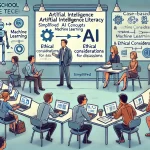
Striking the Right Balance: AI Assistance in Learning to Code
January 31, 2024INTRODUCTION
In the ever-evolving landscape of technology, learning to program has witnessed a transformative shift, thanks to the integration of Artificial Intelligence (AI) tools. The introduction of AI, capable of suggesting or generating source code, has considerably eased the learning curve for aspiring programmers. However, as we delve into this new era of coding education, it is imperative to tread cautiously, emphasizing the need for a delicate equilibrium between leveraging AI assistance and fostering independent thinking.
The Accessibility Revolution: The accessibility revolution in programming education stems from the capabilities of AI to assist learners in various coding aspects. Whether through auto-completion suggestions, code generation, or virtual mentors, AI tools aim to provide a supportive environment for individuals venturing into the intricacies of coding. The allure of a more accessible path to programming proficiency has drawn learners towards these technological aids.
Striking the Balance: A Delicate Art: While the integration of AI in coding education brings forth an array of benefits, it necessitates a discerning approach. Striking the right balance between embracing AI assistance and nurturing independent thinking is crucial for the holistic development of coding skills. In this blog post, we embark on a journey to unravel the challenges and advantages inherent in the intersection of AI and coding education.
Exploring Challenges and Benefits: A Roadmap: Our exploration will traverse through the multifaceted terrain of AI-assisted coding education. We’ll unravel the complexities that learners encounter, dissect the temptations posed by AI tools in times of difficulty, and delve into innovative solutions devised by educators to maintain the integrity of the learning process. Additionally, we’ll shed light on the potential pitfalls of blind reliance on AI-generated code and outline effective strategies for learners to harness the benefits of these tools without compromising the essence of independent learning.
Empowering Learners, Guiding Educators: This blog aims not only to guide aspiring programmers in navigating the vast landscape of coding education but also to offer insights to educators. Understanding the delicate dynamics between learners, AI tools, and the educational process is essential for crafting effective learning environments. By unraveling the layers of challenges and benefits, we hope to contribute to the discourse surrounding the optimal integration of AI in programming education.
The Complexity of Learning to Code
Embarking on the journey of learning to code unveils a multifaceted landscape characterized by intricate syntax rules, bewildering punctuation marks, and a labyrinth of logical structures. This endeavor, while immensely rewarding, demands an abundance of patience and unwavering persistence, particularly for those navigating the uncharted territories of programming as beginners. In this segment, we unravel the complexity inherent in learning to code and delve into the transformative power of consistent practice in sculpting a profound comprehension of this intricate craft.
The Syntax Conundrum: For beginners venturing into the realm of programming, the syntax of various programming languages can appear as an intricate puzzle. Punctuation marks, symbols, and the meticulous arrangement of code demand careful consideration. A missing colon or a misplaced comma can metamorphose into elusive errors, intricately woven into the fabric of coding languages. As novices grapple with these syntactical nuances, the initial phases of the learning process often seem perplexing and overwhelming.
The Journey to Proficiency: Consistency is Key: Amidst the confusion and syntactical conundrums, the journey towards programming proficiency unfolds as a gradual process. Patience becomes an indispensable ally, and persistence emerges as the guiding force that propels learners forward. Consistent practice, characterized by a deliberate engagement with coding exercises, problem-solving, and hands-on projects, becomes the cornerstone of mastering the complex art of coding.
Unraveling the Learning Curve: As learners persist through the initial challenges, the learning curve, initially steep and formidable, gradually unfurls. Concepts that once seemed cryptic and rules that appeared confounding begin to weave themselves into a comprehensible tapestry. The syntax, once a source of perplexity, transforms into a language of expression and creativity. The journey from confusion to clarity, from frustration to fluency, mirrors the transformative power embedded in the act of learning to code.
The Transformative Power of Practice: Consistent practice acts as the catalyst for this transformation, fostering a deep-rooted understanding of programming languages. Repetition and application become instrumental in reinforcing concepts, sharpening problem-solving skills, and cultivating the ability to approach coding challenges with confidence. It is through this iterative process that the complexity of learning to code begins to unravel, paving the way for a profound mastery of the craft.
The Temptation of AI Assistance:
In the quest to unravel the intricacies of coding, many learners, myself included, embark on their educational journey armed with tutorials and programming exercises. Yet, when confronted with formidable challenges along the coding odyssey, the allure of AI tools such as ChatGPT and GitHub Copilot becomes undeniable. These digital assistants, proficient in generating code snippets and providing solutions, present enticing shortcuts. However, the utilization of AI assistance in the realm of coding introduces a nuanced landscape rife with considerations and contemplations.
The Allure of AI Tools: A Double-Edged Sword: As coding novices grapple with complex problems, the convenience offered by AI tools stands out as a double-edged sword. The immediate assistance provided by tools like ChatGPT and GitHub Copilot can be a tempting shortcut, offering swift resolutions to coding conundrums. However, this convenience conceals a dichotomy, raising questions about the balance between leveraging AI assistance and nurturing independent problem-solving skills.
The Learning Journey: Balancing Assistance and Autonomy: The conventional learning path often involves watching tutorials, solving exercises, and gradually building a foundation in coding. Yet, the introduction of AI tools adds a layer of complexity to this journey. The temptation to turn to these tools when faced with challenges can disrupt the delicate equilibrium between receiving assistance and independently navigating the learning process. Striking the right balance becomes imperative to ensure that the educational journey remains enriching and fosters true understanding.
Conscious Decision-Making: Recognizing the Pitfalls: Amidst the allure of swift solutions, learners must engage in conscious decision-making. Recognizing the pitfalls of overreliance on AI tools is crucial. While these tools excel in generating code, they may inadvertently become crutches that hinder the development of critical problem-solving and debugging skills. The conscious choice to strike a balance between leveraging AI assistance and fostering independent thinking emerges as a pivotal aspect of the coding learning experience.
GitHub Copilot: Autocomplete and Autonomy: GitHub Copilot, with its autocomplete feature, exemplifies the intersection of convenience and potential pitfalls. The tool’s ability to swiftly complete code snippets aligns with its purpose of aiding developers. However, learners, cognizant of the temptation to ‘cheat’ by relying solely on autocomplete, must proactively choose when to utilize this feature and when to delve into independent problem-solving.
Educational Strategies: Incorporating AI with Intention: Educational strategies play a pivotal role in navigating the temptation of AI assistance. Institutions and educators, recognizing the prevalence of these tools, can adopt proactive measures. Establishing guidelines, promoting intentional usage, and emphasizing the importance of developing core coding skills independently contribute to a holistic and effective educational approach.
Conclusion: Nurturing Autonomy in the Coding Odyssey: In the ever-evolving landscape of coding education, the temptation of AI assistance serves as a compelling subplot. As learners navigate this dynamic terrain, the essence lies in nurturing autonomy while judiciously leveraging the assistance offered by AI tools. The coding odyssey, enriched by deliberate decision-making and a balanced approach, unfolds as a transformative journey where the allure of shortcuts coexists with the profound satisfaction of independently conquering coding challenges.
Virtual Rubber Duck Debugging:
In the realm of coding education, where the allure of AI assistance looms large, educators are crafting innovative solutions to ensure the delicate balance between support and independent learning. One such ingenious alternative is the introduction of the CS50 duck—a coding chat-bot equipped with guardrails designed to deter students from over-reliance on AI tools for assignments. Drawing inspiration from the renowned practice of rubber duck debugging, this virtual assistant emerges as a catalyst for nurturing independent problem-solving skills and fostering a spirit of self-discovery among coding learners.
CS50 Duck: An AI Companion with Pedagogical Guardrails: The CS50 duck, unveiled as an alternative to AI tools like ChatGPT and Copilot, stands as a testament to educators’ commitment to maintaining the integrity of the learning process. Powered by GPT-4, this coding chat-bot incorporates strategic guardrails to prevent students from succumbing to the temptation of seeking ready-made solutions. While inspired by the traditional rubber duck debugging method, the CS50 duck adds a technological dimension, infusing the educational landscape with a virtual companion that encourages thoughtful exploration.
Inspired by Rubber Duck Debugging: A Time-Tested Approach: Rubber duck debugging, a practice ingrained in software development, involves explaining code-related issues to an inanimate object, often a rubber duck, to stimulate problem-solving through verbal articulation. The CS50 duck extends this time-tested approach into the digital realm, providing students with a virtual entity for dialogue and reflection. By emulating the rubber duck debugging method, this AI assistant becomes a supportive yet non-intrusive companion in the coding journey.
Guardrails Against Cheating: Balancing Support and Autonomy: The strategic inclusion of guardrails in the CS50 duck’s functionality addresses the core concern of educators—maintaining a delicate equilibrium between providing support and nurturing autonomy. While the AI-powered companion offers a conversational space for students to articulate coding challenges, it refrains from delivering direct answers to homework problems. This intentional design encourages learners to embrace the troubleshooting process independently, fostering resilience and a deeper understanding of coding principles.
Positive Feedback and Impact: A Step Toward Transformative Learning: Since its introduction, the CS50 duck has garnered positive feedback, marking a successful experiment in integrating AI into the coding education landscape. The virtual tutor aspect of the duck provides students with on-demand assistance, creating a symbiotic relationship that enhances the learning experience. The impact of this initiative extends beyond the realm of coding assignments, offering educators more time to address diverse aspects of student learning and development.
Looking Ahead: Exploring AI Integration in Education: The CS50 duck’s success underscores the potential for generative AI to complement, rather than disrupt, student learning. As educators explore the impact of AI companions in coding education, the focus shifts toward leveraging technology to bolster student autonomy and engagement. The experiment with the virtual duck sets a precedent for harnessing AI in education with thoughtful consideration for pedagogical goals.
Conclusion: A Virtual Companion in the Coding Odyssey: In the ever-evolving landscape of coding education, the introduction of the CS50 duck emerges as a creative response to the challenges posed by AI assistance. By combining the essence of rubber duck debugging with technological innovation, educators pave the way for a transformative learning journey—one where virtual companions encourage dialogue, resilience, and independent problem-solving, ultimately shaping proficient and self-reliant coders of the future.
The Pitfalls of Copy-Pasting AI-Generated Code:
In the realm of coding education, the integration of AI tools has ushered in a new era of accessibility and assistance. However, the ease of obtaining quick solutions through these tools brings with it a set of pitfalls—especially when it comes to the temptation of blindly copying and pasting AI-generated code. This segment explores the risks involved and emphasizes the crucial need for learners to adopt a discerning “code reviewer” mindset to enhance the quality and understanding of the code they incorporate into their projects.
The Mirage of Quick Solutions: AI-Generated Code and Its Allure: In the dynamic landscape of programming education, AI tools like ChatGPT and GitHub Copilot offer a seductive promise—swift and efficient solutions to coding challenges. The allure of obtaining ready-made code snippets often tempts learners, providing a shortcut to problem resolution. However, this seemingly seamless path to progress conceals potential hazards that may compromise the integrity of one’s codebase.
Blind Copy-Pasting: Unveiling the Risks: The act of blindly copying and pasting AI-generated code into a project may appear expedient, but it introduces a myriad of risks. The generated code, crafted by machine intelligence, may not seamlessly align with the existing structure and logic of the learner’s program. Consequently, this hasty integration can result in the introduction of errors, creating a puzzle of inconsistencies that may prove challenging to unravel.
Quality Erosion: The Unseen Consequence: While the intention behind leveraging AI tools is often to enhance efficiency, the blind incorporation of machine-generated code can inadvertently erode the overall quality of a project. The lack of contextual understanding and the nuances of specific coding requirements may lead to a mismatch between the generated code and the project’s intricacies. As a result, learners may find themselves grappling with issues that stem from the incompatibility of AI-generated solutions.
Crucial Role of Understanding: Empowering Learners as Code Reviewers: To navigate the pitfalls of blind copy-pasting, learners are urged to adopt the role of a discerning “code reviewer.” This involves going beyond the surface-level acceptance of AI-generated code and delving into a comprehensive understanding of its intricacies. By comprehending the rationale behind each line and function, learners empower themselves to identify potential discrepancies and tailor the code to suit the specific needs of their projects.
Zed Shaw’s Insight: Learning to Code with Dual Goals: Zed Shaw, a seasoned software developer and author of “Learn Python the Hard Way,” offers valuable guidance to aspiring programmers. He emphasizes the importance of approaching AI tools with dual goals: first, invest time in learning to code sufficiently to decipher the output of the AI tool, and second, adopt the mindset of a “code reviewer.” This dual-pronged strategy ensures that learners not only leverage AI assistance but also critically evaluate and improve the code generated.
Guardrails for Thoughtful Utilization: Ensuring AI Enhances, Not Hinders: As learners embark on their coding journey augmented by AI tools, it is crucial to establish guardrails that prioritize thoughtful utilization. Acknowledging that AI-generated code is a tool, not a definitive solution, empowers learners to wield its capabilities judiciously. By adopting a discerning mindset, learners transform from passive recipients of code to active contributors, shaping a codebase that reflects both efficiency and quality.
Effective Use of AI Tools:
In the intricate realm of coding education, the integration of AI tools has become a transformative force, promising efficiency and support to learners. However, the key to harnessing the full potential of these tools lies in the art of effective utilization. This section delves into the strategies that empower learners to master the coding craft by using AI tools with clarity, precision, and strategic intent.
The Imperative of Clear Understanding: A Prerequisite for AI Success: Before delving into the realm of AI-assisted coding, learners must cultivate a clear and comprehensive understanding of their coding challenges. The efficacy of AI tools is intricately tied to the clarity with which learners articulate their problems. By unraveling the intricacies of the coding puzzle, learners lay the groundwork for a fruitful collaboration with AI.
Framing Questions: The Art of Precision: AI tools excel when presented with precise, well-framed questions. Learners are encouraged to articulate their queries in a manner that provides AI tools with the necessary context to generate relevant and accurate solutions. The art of framing questions becomes a skill that elevates the effectiveness of AI assistance, enabling learners to extract maximum value from these powerful tools.
GitHub Copilot: Treating AI as a Collaborative Colleague: GitHub Copilot, a prominent AI-powered coding assistant, thrives in an environment where it is treated as a collaborative colleague. Learners are advised to interact with this tool as they would with a partner in coding endeavors. By emphasizing collaboration and providing detailed context in prompts, learners enhance the AI’s ability to respond with tailored and contextually relevant code snippets.
Inbal Shani’s Insight: Providing Context for Nuanced Responses: Inbal Shani, Chief Product Officer at GitHub, underscores the significance of providing detailed context when engaging with AI tools. According to Shani, treating GitHub Copilot as a collaborative colleague involves sharing the intention behind the code and the specific problem the learner aims to solve. This nuanced approach results in more accurate and nuanced responses from the AI, enriching the collaborative coding experience.
Strategic Intent: Leveraging AI as a Catalyst for Proficiency: Effectively using AI tools extends beyond seeking immediate solutions. Learners are encouraged to approach AI integration with a strategic intent—to use these tools as catalysts for proficiency. By viewing AI as a supportive ally rather than a substitute for the learning process, learners position themselves to glean insights, enhance their coding skills, and accelerate their journey toward mastery.
The Evolving Landscape: Adapting to the Dynamics of AI-Augmented Learning: As AI continues to reshape the educational landscape, learners must adapt to the evolving dynamics. Embracing AI tools as valuable companions in the coding journey requires a mindset that combines technical acumen with strategic thinking. This adaptive approach ensures that learners navigate the coding landscape with agility, leveraging AI to amplify their learning endeavors.
Conclusion: The Synergy of Learner and AI: Unlocking Coding Mastery: In the symbiotic relationship between learners and AI tools, the effective use of these technological companions emerges as a linchpin for unlocking coding mastery. Clear understanding, precision in framing questions, collaborative engagement with tools like GitHub Copilot, and a strategic intent collectively propel learners toward proficiency. As the coding landscape evolves, the synergy between human ingenuity and AI capabilities becomes the guiding force, transforming coding education into a dynamic and enriching journey.
Guidance for Learners:
Embarking on the odyssey of coding education with AI companions by your side requires a nuanced approach and a set of guiding principles. In this segment, we distill the wisdom that empowers learners to navigate the complex landscape of AI-infused learning, ensuring not just proficiency but a profound understanding of the coding craft.
Goal #1: A Foundation of Coding Knowledge: The first beacon on your journey is the establishment of a robust foundation in coding knowledge. To wield AI tools effectively, learners must ascend the steps of coding literacy, acquiring an understanding of programming languages, syntax rules, and fundamental concepts. This knowledge serves as the compass that guides learners through the intricate terrains of AI-generated code.
Goal #2: Embrace the Code Reviewer’s Mantle: As you ascend the coding summit, don the mantle of a diligent code reviewer. This role transcends mere acceptance of AI-generated code; it demands a discerning eye that identifies nuances, evaluates logic, and ensures alignment with best coding practices. By adopting the code reviewer’s mindset, learners transform into architects of quality, elevating the standards of the code they produce.
The Crucial Art of Critical Thinking: In the realm of AI-assisted coding, critical thinking emerges as a formidable ally. Resist the allure of blind reliance on AI solutions. Instead, approach AI-generated code with a critical lens, questioning, dissecting, and understanding each line. The tools are aids, not substitutes, and embracing a critical mindset ensures that learners remain architects of their coding destinies.
Zed Shaw’s Proclamation: Assume Mastery, Verify Solutions: Zed Shaw, seasoned software developer and author of “Learn Python the Hard Way,” issues a clarion call: always assume mastery over AI tools. Treat them as less-skilled programmers, urging learners to verify solutions independently. This ethos ensures that learners retain agency over their coding narratives, using AI as a trusted companion rather than an infallible guide.
Charles Severance’s Cautionary Note: Unveiling Illusions of Assurance: Charles Severance, a luminary in computer science education, underscores the illusion of assurance in AI-generated solutions. The phrases offered by AI tools may be reassuring, but learners must resist the temptation to forego critical scrutiny. Interrogate the solutions, validate their correctness, and let a spirit of inquiry be the lodestar in your coding expedition.
A Symphony of Mastery and AI Synergy: In the grand symphony of coding mastery, the harmonious integration of human intellect and AI prowess takes center stage. Learners, equipped with foundational knowledge, a code reviewer’s acumen, and a shield of critical thinking, orchestrate a masterpiece where AI tools complement their journey without overshadowing the brilliance of human ingenuity.
The Role of Educators:
In the ever-evolving landscape of coding education, educators serve as guiding lights, steering learners through the dynamic intersection of human intellect and artificial intelligence. As coding enthusiasts delve into the realm of AI-assisted learning, educators play a crucial role in shaping the responsible and effective use of these powerful tools.
- AI with Guardrails: Educators understand the delicate balance between facilitating learning and preventing undue reliance on AI tools. Introducing innovative solutions like the CS50 duck—a coding chat-bot equipped with guardrails—showcases the commitment to fostering independent problem-solving. This virtual companion, inspired by the concept of rubber duck debugging, encourages students to articulate their coding challenges without succumbing to the allure of instant solutions.
- Supporting Self-Discovery: The CS50 duck, and similar AI-based educational tools, are designed not to merely provide answers but to support learners on their journey of self-discovery. By restricting responses to queries related to the course and refraining from supplying direct solutions to homework problems, educators ensure that AI remains a guiding force rather than a shortcut that undermines the learning process.
- Pedagogical Guardrails: Building AI-based software with pedagogical guardrails is a strategic approach adopted by educators. These guardrails act as ethical and educational boundaries, preventing AI tools from inadvertently hindering the development of critical thinking and problem-solving skills. The CS50 duck’s positive reception underscores the effectiveness of such guardrails in creating a supportive yet challenging educational environment.
- Balancing Assistance and Independence: The role of educators extends beyond teaching coding syntax; it encompasses instilling a mindset that balances assistance from AI tools with the independence required for effective learning. By setting policies that discourage the use of third-party software for assignments while endorsing the use of carefully crafted AI tools, educators guide learners to leverage technology responsibly.
- Shaping the Future of AI in Education: Educators engaged in the development and implementation of AI tools for coding education actively contribute to shaping the future of this intersection. Research endeavors, such as the analysis of the CS50 duck’s impact, provide valuable insights into the positive outcomes and potential challenges associated with integrating AI into the educational landscape.
In the coding cosmos, educators emerge as guiding lights, illuminating the path for learners navigating the complexities of AI-assisted programming. By embracing innovative solutions, establishing pedagogical guardrails, and fostering a mindset of balanced reliance on AI, educators play a pivotal role in nurturing the next generation of proficient and ethically responsible coders.


















